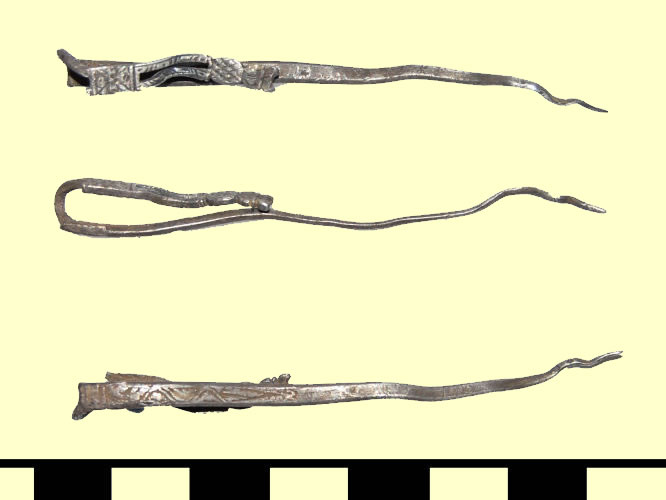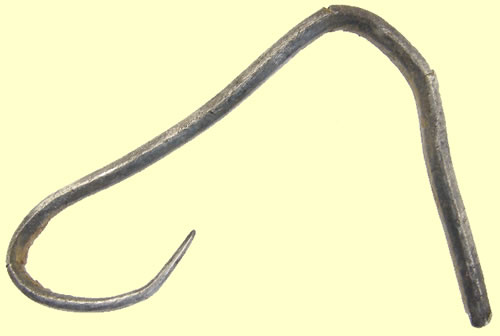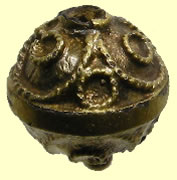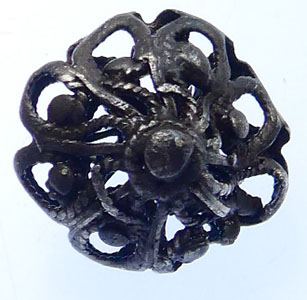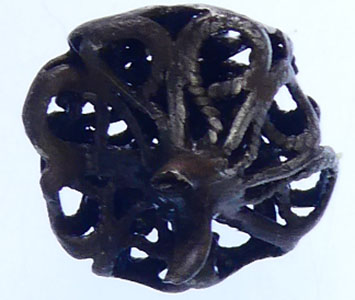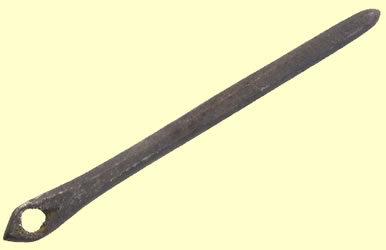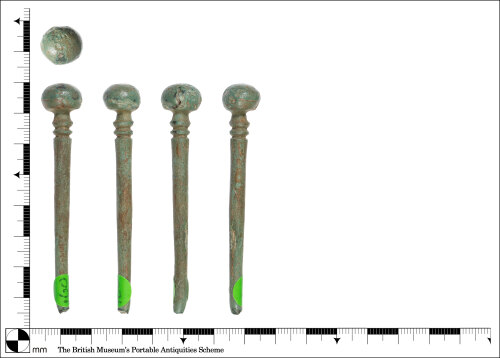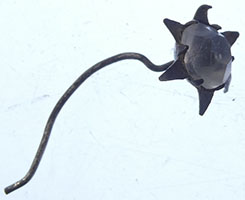

Metal detecting holidays in England with the World's most successful metal detecting club.20 years plus.
Twinned with Midwest Historical Research Society USA.
Sewing, bodkin needles and pins |
Treasure Case: 2010 T166 Dress Pin (Bodkin) Date of Discovery: 1st March 2010 Circumstances of discovery: Whilst searching with a metal detector. Description: Distorted and damaged cast silver dress-pin with incised decoration. The terminal is in the shape of a pineapple, formed of a cross-hatched oval with an upside down triangle representing the foliage. There is an incomplete loop at the apex of the pineapple. There are two rectangular 'eye' openings separated by a rectangular panel containing a flower motif. The upper opening has oblique lines to either side. The lower opening only has one edge surviving. The shaft has a rectangular cross section and it tapers to a point. A zigzag motif extends part way along the shaft on both sides. The pin it bent back on itself at the point of the second rectangular opening. The tip of the pin has several bends. In its current condition, it measures 69.92mm long, has a maximum width of 3.62mm, is 1.52mm thick and weighs 2.68 grams. If straight, the pin would be approximately 97mm long. Date: Post Medieval - 17th Century Disposition: Disclaimed The object contains a minimum of 10% precious metal and is over 300 years old. Consequently it qualifies as Treasure under the stipulations of the Treasure Act 1996 in terms of both age and precious metal content. Laura McLean Finds Liaison Officer, Essex. Colchester & Ipswich Museum Service. April 2010 Subsequent actionsSubsequent action after recording: Returned to finder after being disclaimed as Treasure ChronologyBroad period: POST MEDIEVAL
Treasure case:2007 T571
17thC silver bodkin needles
|
TREASURE CASE 2009 T522 post-medieval silver dress pin British Museum Report Dr Dora Thornton British Museum Discription: Silver pin of "bodkin type", quadrangular section broken off at point where longitudinal opening would have been, tapering to a point. Plain on back, etched on front with flower-head and chevron design with foliate infill. Date: 17th Century type. Conclusion: As such, due to its age and precious metal content, this object qualifies as Treasure under the stipulations of the Treasure Act 1996. Dimensions: In its distorted condition it is 38.62mm long; if straightened, it would be approximately 80mm long. It is 3.83mm wide, 2.02mm thick tapering to 1.39mm wide, 0.95mm thick. It weighs 3.47 grams. Subsequent actionsSubsequent action after recording: Returned to finder after being disclaimed as Treasure Treasure detailsTreasure case tracking number: 2009 T522 ChronologyBroad period: POST MEDIEVAL Date from: Circa AD 1600 Dimensions and weightWeight: 3.47 g Materials and constructionPrimary material: Silver Manufacture method: Cast Completeness: Incomplete |
Treasure case:2007 T539 Post Medieval (17th century) incomplete silver dress pin. There is a break across a rectangular slot at one end. The pin is decorated with incised lines below the eye, and is inscribed with the intials EF. It is bent half way along its length. It would have measured approximately 100mm long if straightened. It is rectangular in cross section, measuring 5.08mm by 2.80mm at eye end and 0.77mm by1.47mm at tip. It weighs 6.66 grams. Notes: British Museum Report on Treasure 2007 T539 Silver dress pin , quadrangular shaft bent along its length and tapering to a point, broken at rectangular opening at one end. Undecorated other than the engraved owner’s initials EF on the underside. Late 17th Century. As such, due to its age and precious metal content, this object qualifies as Treasure under the stipulations of the Treasure Act 1996. A common type, frequently reported through the Treasure Act. Dr Dora Thornton, Curator of Renaissance Collections
Class: Dress Subsequent actionsSubsequent action after recording: Returned to finder ChronologyBroad period: POST MEDIEVAL Date from: AD 1650 Dimensions and weightWeight: 6.66 g Materials and constructionPrimary material: Silver Manufacture method: Cast Completeness: Incomplete |
17thC silver bodkin needle |
TREASURE CASE 2008 T165 Post Medieval hollow silver artifact British Museum Report on 2008 T165 This pin is undiagnostic and hard to date, but likely to be post 1708. It therefore falls outside the remit of the Treasure Act 1996. Dr Dora Thornton, Curator of Renaissance Collections Additional indformation: Hollow silver pin of uncertain date. It is 35.61mm long, 8.05mm wide and weighs 0.9 grams. The pin has a square cross section at the head, changing to a quatrefoil cross section along the length of the shaft. The shaft tapers in thickness, and is incomplete with a worn break. Laura McLean Finds Liaison Officer (Essex) Subsequent actionsSubsequent action after recording: Returned to finder ChronologyBroad period: POST MEDIEVAL Date from: Post AD 1708 Dimensions and weightLength: 35.61 mm Materials and constructionPrimary material: Silver Completeness: Incomplete
|
Stunning 16thC Tudor gilded silver pin Pin dia 10.88mm, 4.68g Treasure case 2009T596 16thC Tudor decorated silver pin . Complete and undamaged with much of the original gilding Pin dia 10.88mm, 4.68g PAS find id: ESS-5D8754
Treasure number 2007 T538: Post Medieval silver dress-pin-head. The spherical hollow cast pin head has a transverse line dividing it into two hemispherical sections. The surface has with applied filigree decoration in the form of circlets and knobs. Each hemisphere has three circlets, each containing three smaller circlets forming a trefoil with a central knob. Two of these knobs are missing from the lower hemisphere. The larger circlets are divided by knobs, and there is a further knob at the apex of the pin head. There is a worn break where the shaft was attached. The surface of the pin is dull grey, with some of the original silver colouring showing through. This pin-head is of typical 16th century design. See Treasure Annual Report 2004 no 295 for comparison. Dimensions: Diameter: 9.32mm, length: 9.85mm, weight: 1.60 grams. Notes: British Museum Report Treasure number 2007 T538 Spherical dress pin head with central rope twist band around the centre, filigree circlets and knops all over the surface. Signs of where the pin shaft was originally soldered on. A common type frequently reported through the Treasure Act. 16th Century. As such, due to its age and precious metal content, this object qualifies as Treasure under the stipulations of the Treasure Act 1996. Dr Dora Thornton, Curator of Renaissance CollectionsSubsequent actionsSubsequent action after recording: Returned to finder ChronologyBroad period: POST MEDIEVAL Date from: AD 1500 Dimensions and weightLength: 9.85 mm Materials and constructionPrimary material: Silver Manufacture method: Multiple Completeness: Incomplete
Treasure 2008 T584 Post Medieval silver pin head, with traces of gilding. Post Medieval (16th century) globular pin head, cast in silver with gilding. There is a small circular depression where the shaft would have extended from. The pinhead is divided into two hemispheres by a raised band. Each hemisphere has four raised circular domes surrounded by a beaded border. There is an integrally cast knop between each dome and the dividing border, one of which is missing from the lower hemisphere. The upper hemisphere has an additional knop at its apex. It is 10.60mm long, 10.92mm in diameter and weighs 2.94 grams. British Museum Report: Silver-gilt pin head from a dress pin, shaft broken off at head. Decorated on each hemisphere with large gilt lobes with cable ornament around them and knops in between. Part of a 16th Century dress pin of a kind frequently reported through the Act. For a very similar pin see TAR 2005-6, no. 789. As such, due to its age and precious metal content, this object qualifies as Treasure under the stipulations of the Treasure Act 1996. Dr Dora Thornton, Curator of Renaissance Collections The British Museum ChronologyBroad period: POST MEDIEVAL Date from: AD 1500 Dimensions and weightLength: 10.6 mm Materials and constructionPrimary material: Silver Completeness: Fragment Surface Treatment: Gilded
TREASURE CASE 2009 T523 Post Medieval pin Date of Discovery: 22nd September 2009 Circumstances of discovery: Whilst searching with a metal detector Description: Incomplete cast silver gilt pin head. The surviving section is one half of a hollow sphere with applied filigree decoration. The decoration is comprised of three sets of two concentric filigree circles containing a central knop, with a further knop between each set of concentric circles. At the apex of the head is a small circular hole. The gilding survives over most of the surface however it is missing on the knops. It is 8.84mm in diameter, 4.71mm deep and weighs 0.71 grams. Date: Post Medieval, 16th century. Disposition: Disclaimed The object contains a minimum of 10% precious metal and is over 300 years old. Consequently it qualifies as Treasure under the stipulations of the Treasure Act 1996 in terms of both age and precious metal content. Laura McLean Finds Liaison Officer, Essex. Colchester & Ipswich Museum Service. January 2010 Subsequent actionsSubsequent action after recording: Returned to finder after being disclaimed as Treasure Treasure detailsTreasure case tracking number: 2009 T523 ChronologyBroad period: POST MEDIEVAL Date from: Circa AD 1500 Dimensions and weightThickness: 4.71 mm Materials and constructionPrimary material: Silver Manufacture method: Cast Completeness: Fragment Surface Treatment: Gilded
Gold 16thC Tudor pin heads
16th C Tudor gilded silver pin head 4.89g, 12.17mm dia
16thC Tudor gilded silver pin
16thC Tudor gilded silver pin
16thC Tudor decorated silver fretwork pin head
Late medieval silver fretwork pin
Medieval gold pin head
Very unusual silver pin - possibly late medieval
" Saxon pin head
A copper-alloy, near complete pin, most likely dating from the medieval to early post medieval period (AD1200-1650).
An incomplete cast copper-alloy pin (Cool Group 6) of Roman date (c.50-150).
An incomplete, copper alloy hairpin probably of Roman date, about AD 43 - 410.
An incomplete cast copper alloy pin of Early Medieval date (c. AD 700-900).
A medieval copper alloy pin fragment, probably dating to c. AD 1200-1400.
Picture at the British museum
A complete copper-alloy Roman pin of probable mid first to mid second century date
Roman decorated stick pin
An incomplete copper-alloy dress or hair pin of Early-Medieval date, c.AD 700 - 900.
An incomplete copper-alloy dress or hair pin of Early-Medieval date, c.AD 700 - 900.
A complete copper-alloy dress or hair pin of Early-Medieval date, c.AD 700 - 900. The pinhead is polyhedral, with a single ring and dot decoration on each of the four main sides. From the base of the head a straight circular sectioned shaft extends terminating in a worn break. A slight raised collar is present at the junction between the head and the shaft.
|
|
